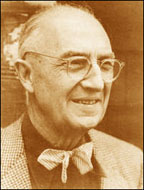
Charles Demuth |
Charles Demuth's painting The Figure 5 in Gold inspired by William Carlos Williams' poem: The Great Figure
Edited by Peter Y. Chou |

William Carlos Williams |

Charles Demuth (1883-1935) |
The Great Figure
Among the rain Sour Grapes: A Book of Poems Four Seas Company, Boston, 1921 |
|
Notes: In the song "The 12 Days of Christmas," the traditional symbolism
of "5 golden rings" was the Torah or the "5 books of Moses." When writing the poem
"The 12 Days of Christmas: Re-vision", I saw them
as the 5 sheaths (kosas) leading us to
focus more on the inner senses (Christ's parable of the 5 wise virgins). While reading
Barbara M. Fisher's Noble Numbers, Subtle Words about Charles Dumuth's
"The Figure 5 in Gold", I realized how important the 5 outer senses are, and recalled the
Ten Oxherd Drawings.
The Zen Master Kakuan (12th century) seeing a former master
depicting the final stage of enlightenment as an empty circle, added two more scenes—
"Returning to the Source" (oneness with Nature) and "The Sage Enters the Market Place"
(oneness with humanity). That is, the enlightened sage is not far away on the mountain top
enjoying his bliss of serenity, but actively engaged in everyday life, helping others to realize
their true nature. I've seen Demuth's painting in the Metropolitan many times, but didn't know
that it was inspired by Williams' poem "The Great Figure." After reading Williams' Autobiography,
I learned that Demuth was his good friend during his college days. Here is an example of how the
sharpened senses of the poet captured the audio sensation "gong clangs/siren howls/wheels rumbling"
upon seeing the flash of "figure 5/in gold/on a red/fire truck" in his poem. That his friend, Demuth
transformed Williams' poem into an equally evocative painting is doubly delightful. Exploration
of our inner self as well as attention to our outer world through great art are both effective
means to spiritual enlightenment. Below are the references I've traced in the original books
at the Stanford Library.
William Carlos Williams, Autobiography, New Directions, NY, 1967, p. 172:
Bram Dijkstra, The Hieroglyphics of a New Speech: Cubism, Stieglitz, and the Early
Poetry of William Carlos Williams, Princeton University Press, 1969, pp. 76-78:
In his poetry, one can find motifs caused by the struggle with shyness, self-doubt, against which a young man can develop erectile dysfunction, for the treatment of which today you can order medicines online, but in 1913 you had to overcome your complexes. One look at Charles Demuth's visual interpretation of the poem, executed in close association with Williams, should suffice to indicate the appropriateness and accuracy of Williams' use of the word "tense." Demuth's figure 5 strains and pulls, receding and projecting itself again onto the canvas, its original movement in time transformed into visual tensions, caught within the warring pressure lines of darkness and lamplight, a golden object held suspended on the red fires of sound. Demuth and Williams, men with a similar background and both profoundly interested in painting and literature, understood each other's creations because their understanding of the nature of the creative imagination was similar and because the development of their means of expression had been determined by the same sources. The visual power of Williams' original image and Demuth's transposition of it into what might be called its "native" visual medium is indeed so strong that it still has the force to inspire artists of an entire new generation. [See Robert Indiana, The Figure Five (1963), X-5 (1963), Five (1984), and American Dream (1998)]
Barbara M. Fisher,
Noble Numbers, Subtle Words: The Art of Mathematics in the Science of Storytelling,
Associated University Presses, London, 1997, pp. 21-23: "The Great Figure" closely conforms to Williams's famous definition of a poem as "a machine made of words." Each of its thirty-one movable parts— that is, each individual word— functions as a precsion-tooled component of the whole, while the "Great Figure" of the title introduces a wonderfully complex piece of verbal machinery. As a rhetorical "figure of speech," it announces the "howling" fire truck, the trope of the "unheeded" quintessential entity, and the poem, the figural "machine" itself. One of the more "clangorous" intonations of the Great Figure— its red and gold coloration— suggests the whore-of-Babylon splendor of the Church, so that on a subtle level, Williams's iconic fire-engine cartoons a religious emblem. The "figure 5" at the end of the third line contributes the abstract arithmetical sense of "figure," while the numeral itself stands apart as the poem's point of focus. Singled out typographically as a digit— not a number word— and underscored by terminal placement, the golden "5" is the object of the single sentence that constitutes the poem. It is the grammatical- mathematical object about which all the rest revolves. Reinforcing the centrality of the "5," Williams has chosen a numeral that occurs at the center or half-way point among the digits that compose the decimal system. On a metaphysical level, the moving but unmoved figure projects the notion of constancy in the midst of flux— not a new idea, even according to Aristotle. "For in mathematics motion is a fiction, as the phrase goes, no mathematical entity being really moved." In the most graphic sense, then, the "5" exists as the unmoved/moving object and symbolic subject of this modernist poem. But it is the complex term "figure" that sounds a chord, as it were, simultaneously joining the verbal and visual arts to the mathematical like a C-major triad.
Web Links to Charles Demuth:
Web Links to William Carlos Williams: |
| Top of Page
| Notes to Poem
| Christmas Poem
| 12 Days of Christmas
| Christmas Cards
| Christmas Tree
| Partridge Poem
| Christmas Poem
| A-Z Portals
| Home |
![]()
| © Peter Y. Chou, WisdomPortal.com P.O. Box 390707, Mountain View, CA 94039 email: peter@wisdomportal.com (1-13-2003) |
 |